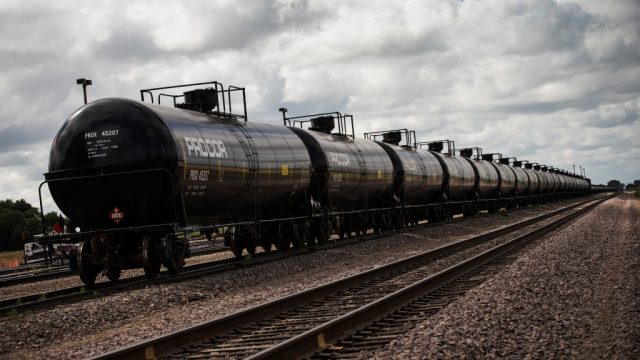Glawe Column: Are All NTSB Recommendations For Rail Safety Plausible?

Sitting inside Urban Stampede, at the intersection of 4th and Kittson in downtown Grand Forks, one can easily imagine what it would look like. The cars roll slowly through the intersection as motorists wait for the mechanical arms that guard the railroad tracks to rise, signalling the go-ahead. Among the payload are the coal black cylinders carrying crude oil from the Bakken. From the front stoop of the coffee shop, you can lob a baseball and ping it off the tanker cars.
They are close. And after Casselton they started looking a hell of a lot closer. A friend calls it a “parade of bombs.”
Of the three recommendations announced by the NTSB Thursday regarding rail transport of crude oil, one stuck out as being difficult, if not impossible, to meet.
The first recommendation “… would require expanded hazardous materials route planning for railroads to avoid populated and other sensitive areas.”
What this says to me is that the NTSB would prefer tanker cars full of what has shown to be a more explosive brand of crude oil not run through areas where people live. (The people probably prefer this, too.) The decision comes in part because of the horrific disaster that occurred in Quebec this summer, when dozens were killed as explosive fireballs overtook their homes.
As many who live in the north end of Grand Forks can attest, railroad tracks transporting crude oil run directly through neighborhoods. Casselton residents are also aware of the close proximity between railroad tracks and residences. So how exactly are railroad companies supposed to abide by the NTSB’s first recommendation?
The answer, it would seem, would be for a massive reworking of track infrastructure away from homes, neighborhoods and cities themselves. NTSB spokesman Eric Weiss side-stepped the dilemma posed by the recommendation, saying railroad companies should route hazardous materials like crude oil with “consideration to population areas and the environment.”
For Casselton, where about 400,000 gallons of oil were spilled last month following a derailment there, that would mean creating tracks that run around the city, not directly through it. The same goes for several neighborhoods in Grand Forks, where cars carrying oil for countrywide destinations and grain for North Dakota Mill and Elevator, among materials for other industrial facilities, run through backyards.
BNSF spokeswoman Amy McBeth told me the company has invested north of $500 million in their operations in North Dakota in the past four years. She did not say whether any of those funds were used to construct new tracks, but praised the company’s safety record, efforts to maintain infrastructure and prevent accidents.
“BNSF inspects track and bridges more frequently than required by the (Federal Railroad Association) to help ensure they are safe,” McBeth wrote in an email. “And detectors on our rail lines monitor each passing railcar for stresses on the wheels or other components to help prevent equipment failures before they occur.”
All well and good. Those practices seem to be along the lines of the safety audits that made up two of the NTSB’s recommendations released yesterday. But the first one still seems implausible.
Here in Grand Forks, the “population area” that many tracks run through is home to not just neighborhoods, but facilities that could complicate matters for emergency responders in the event of a derailment. They include UND’s REAC building, a facility that is currently leasing space and is certified to contain “dangerous biological agents.” It sits about a half block from tracks that regularly carry tanker cars alongside Demers Avenue.
They roll almost silently there, with just the squeaking of metal on metal as wheels meet tracks. Motorists wait at the intersection for the trains to pass, and they always do, without complications.
Accidents like the one in Casselton and Quebec are relatively rare. But whether you think stronger tanker cars, more regulations, or pipelines that take the oil off tracks and puts it underground would make us all safer, I think we can agree on one thing: None of us wants to be there when the parade stops, and decides to put on an impromptu fireworks show.




